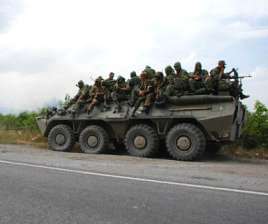
TBILISI, DFWatch–The situation is still tense in the conflict region five years after the Russia-Georgia war, which resulted in hundreds of deaths and the occupation of two Georgian breakaway territories by Russia.
The recent tension was caused by Russian soldiers moving the so-called border, which led to several houses and agriculture lands ending up on the other side.
Wednesday, the Foreign Affairs Ministry of Georgia issued a statement which says that despite the attempts of the Georgian government, Russia is not taking responsive steps. It also says that five years after violating sovereign territory and large scale military aggression against an independent state on August 7, 2008, Russia still occupies 20 percent of Georgian territory, which contradicts fundamental principles of international law.
“It deprives hundreds of thousands of victims of several waves of ethnic cleansing, including that of 2008, of their internationally recognized right to a safe, dignified and voluntary return,” the statement says. “This has been concurred by Russia’s persistent efforts to obtain the recognition of Georgia’s occupied regions under its effective control and heavy military presence, including through active application of political, military and economic leverages.”
370 persons died in Georgia after the five day war. 228 of them were civilians. 2 232 were wounded – this is the final official information which DF Watch received from the Defense Ministry.
Last year, it was officially published that were 190 civilian victims.
Three journalists died, two Georgians and one Dutch. Russian soldiers killed several prisoners after torturing them because they refused to insult the Georgian flag. Video footage of their torture exists and a few days ago, the president’s administration republished it.
According to the Defense Ministry of Russia, there are two military bases in the breakaway regions. A ‘Fourth Base’ was established in South Ossetia on February 1, 2009, at a military base already built by Russians before the war.
In 2010, Yury Tanayev, de facto Defense Minister of breakaway South Ossetia, and Russian Defense Minister signed an agreement, which let Russia lease the military base for 49 years without any fees and has the right to set up military infrastructure, including a military airfield.
The same conditions apply for the ‘Seventh Military Base’ which is in the Abkhazian region. It is also in force from February 1, 2009, with this name and with same rights. There are four thousand military service personnel on this base, a number which does not include relatives of soldiers or infrastructure personnel.
Late at night on August 7, 2008, war broke out as the Georgian army attacked Tskhinvali, after growing tension for several weeks. Russia officially engaged in war on August 8. Georgia claims that Russia had its army and military equipment in place earlier.
The war lasted five days. Georgia had to leave territories which it controlled before the war – Akhalgori in South Ossetia and Kodori Valley in Abkhazia. Russian soldiers went beyond the borders of the conflict regions and occupied several large towns in Georgia, including Gori, in the Shida Kartli region, and Zugdidi, in the Samegrelo region.
August 9-10 there was a fear in Tbilisi that the soldiers would also invade the capital as their units were about 35km away from the capital.
After mediation by French president Nicolas Sarkozy, the a ceasefire agreement was reached August 12. Georgia signed it in Tbilisi on August 15 and Russia on August 16 in Moscow. August 12, then President Dmitry Medvedev issued the ceasing fire order, but attacks continued in Shida Kartli, as the Russian army remained passive while paramilitaries from North Caucasus and Tskhinvali continued their raids and civilians were robbed.
After the ceasefire agreement, Russia withdrew most of its armies from the Samegrelo Region in western Georgia and the Shida Kartli region. Buffer zones were set up close to the borders of Abkhazia and South Ossetia, while surveillance points were left in three settled points (Poti, Senaki and Perevi). August 26, Russia recognized the independence of South Ossetia and Abkhazia.
The term ‘occupation’ in connection with Russia’s presence in the breakaway regions was first used by U.S. Secretary of State Hillary Clinton in 2010. The Council of Europe also passed its first official document which mentioned the term ‘occupation.’
In November, 2010 at a NATO Parliamentary Assembly, the term ‘occupation’ and ‘ethnic cleansing’ were used in a resolution. The term was also used in a document adopted after a conference of the Council of Europe and Parliament of Georgia in March 2011.
In November 2011, the term was first used in an official EU document.
In spring 2013, Russia attempted to get the term ‘occupation’ removed from documents of the Council of Europe, but didn’t manage and it remains in the documents.
In November 2011, the Council of Europe passed a resolution about Georgia which calls for EU member states to recognize Abkhazia and South Ossetia as ‘occupied territories.’ 27 members of the Council of Europe, which are members of the EU, adopted five point statement of Secretary General of the Council of Europe on Russia-Georgian war.

